Sponsored by Battle Quest Comics
By Brian Hibbs
It’s the end of the year as I write this, so much of my time goes into looking back over the year, and how things went (if you were to care: here is the EOY report for Comix Experience), and, as in most modern years, I am especially struck by how periodical comics are growing weaker and weaker here.
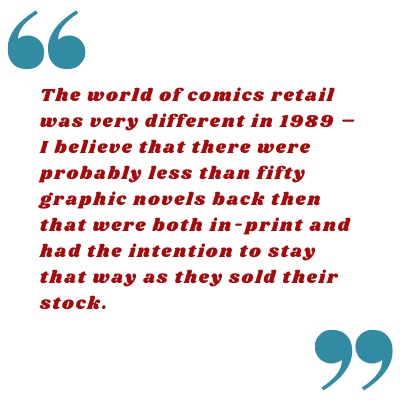
So, being a store that has done this for decades (we celebrated a third of a century in 2022) the thing I always do is look back over the changes over the years, to try to analyze what has happened. Luckily, I still have my very first paper order form, submitted just before we opened (February 1989, for April shipping), which helps me with a perspective that I otherwise would have not had.
The world of comics retail was very different in 1989 – I believe that there were probably less than fifty graphic novels back then that were both in-print and had the intention to stay that way as they sold their stock. You really couldn’t have a store back then where GNs were the majority of your sales or rack space (It is about 60% for us in 2023!). Periodicals ruled the roost for new products, and most comic stores were predominately back issue stores. Hell, we were at the start, because that was the only viable path.
Marvel comics solicited 51 new periodicals for sale that April 1989 (and two new graphic novels/trade paperbacks) and DC solicited 57 periodicals and three GN/TPs. Looking at the newest catalog (Jan 2023 for March 2023 shipping) Marvel has a staggering 229 periodicals (though only representing 67 distinct titles – the rest are variants) and 47 GN/TPs, while DC is publishing 197 periodicals (just 49 distinct series) and 20 GN/TPs.
So, this is the first place that the production of the market has changed: too many titles, and too much overproduction. Marvel is publishing nearly a third more titles, and by and large they’re not new characters or things aimed at expanding their audience. Rather they’re generally expansions of existing franchises, for example five distinct comics that are branded as “Avengers”. While at DC, they’re publishing 15% fewer series, but of their 49 series, a preposterous 24 of them – nearly half! – are “Batman”-family characters.
The truth is that the more you over-produce, the fewer people are willing to buy in. Especially when we look at the customers of the “universes” of Marvel and DC, there is a tendency for readers to want to be “all in” in those universes, because (at least notionally) the works are all interconnected. This, of course, becomes far less true as production scales up (keeping continuity on six “Batman” comics was hard enough. Keeping it on 24? Nigh impossible). If one of your primary selling points is the breadth of your tapestry, it’s very noticeable as your threads begin to fray.
I still remember vividly how we used to have “Marvel Zombies” to the point where even the weakest possible title (Say, the reprint “Marvel Tales”) would sell at least ten copies from the rack for us; while the best-sellers were easy triple digit sales. Nowadays, there are multiple Marvel comics where we are not racking a single copy due to lack of interest, and the top-level sales have plummeted precipitously – by 1992 we were selling more than 150 copies of our best-selling Marvel title, while today it isn’t even 50 copies any longer.

The second clear problem is the overproduction of variant covers. Back in ’89, not one of those comics I ordered had more than one cover. Today, Marvel is publishing an average of 3.5 covers for every book, while DC is at nearly 4! The real problem with the SKU-bloat of Variant covers is that it is largely a publishing methodology based on fear, rather than one of joy and wonder and fun. Fear of Missing Out (FOMO) rules the day, rather than FOOM (Friends of Ol Marvel), if you’ll allow me some tortured wordplay. It isn’t bad enough that so much of modern periodical publishing appears to rely on the obsessive-compulsive disorder that affects certain fans, but in 2023 a significant percentage of these multiple covers aren’t shown to us more than ninety-six hours before the orders are due, preying on the fears of the retailer of possibly missing out on sales of a “hot” cover and comic.
(I’ve discussed this in the past, but for Comix Experience at least, I can see that while roughly a third of our periodical sales are coming from weekly buyers [and yes, the biggest customers are generally in this pool], another third is coming from people who come in approximately monthly, while the final third are customers who buy closer to quarterly. If the economic focus of your publishing line is about trying to sell more copies of the same book to the same customers, then I think it’s actually much more essential to be able to present those variant covers with much more lead-time so that the majority of customers are given a chance to see and order them.)
But it just isn’t sustainable to have three or four covers on your average comic. It radically scales up the risk for the retailer, and it creates confusion at the point of sale for the consumer. We hit peak insanity the week I write this as Marvel published an issue of “Amazing Spider-Man” with a Disney-character homage that had the “Avengers” logo as the front-cover presentation, since it was an Avengers Homage cover.
New this Wednesday! Amazing Spider-Man #17 Disney Avengers Tribute! Members DM for reservation. Quantity limited! #disney #spiderman #avengers #comic #new #mickeymouse #donaldduck #minniemouse #goofy #daisyduck pic.twitter.com/5GKBRi8LX7
— Metropolis Comics (@MetroheroBF) January 9, 2023
Tied to this is the incessant restarting and renumbering of series. Periodical comics are, largely, about building consistent reading habits that feeds the “soap opera” nature of most serial fiction. But every “jumping on” point with a new issue first issue for a new creative team functions more as a “jumping off” chance in the 21st century because of all of impacts from overproduction of series and variants.
As Heidi has rightly pointed out, we no longer have sales charts for the comics industry, so it’s really difficult (if not impossible) to see what the impacts of all of these things are, but I can relate my own anecdotes. When long-running series get restarted, sure we get a spike for an issue or three (often driven by speculators rather than new genuine readership, however), but after that, it usually evaporates back to previous sales levels or lower pretty immediately. Worse still, it generates an unnecessary amount of work for many retailers who have to convert standing orders and ordering data over between one “series” as the next. This would be fine if we were consistently growing audiences, but, more often than not I see it giving readers a bigger chance for escape.
Similarly, the number of mini-series that are focused on characters who already have on-going series (often multiple) usually only splits the audience, and seldom grows it. Here is the thing about the periodical: a significant percentage of the viability of the format comes from the long-term ability to sell back issues to future collectors (You’d think the rise of trade paperbacks would have eliminated that audience, but most mainstream TPed material doesn’t stay in print past a single printing). Back in 1989, you’d be able to take that $1 cover priced comic and sell it for $1.25, which made it rational to hold on top stock for the year or five to increase your margin. But the $3.99 common back issue comic can only be priced at $4.50, and only has people looking for it as long as that series is “active”. Who is still looking for “Amazing Spider-Man” series 3 when we’re currently at v5? And that’s for an ongoing series! More importantly to this point: who is looking for the 2nd issue of some random “Spider-Man” mini-series a year or two after all three or five issues have shipped? Virtually no one. And this means that huge chunks of the “back issue” comics that are being created every month have absolutely no long-term sales potential.
Worse still from my point-of-view is that the “discount” value of “junk” comics hasn’t scaled appropriately over the years – when new comics were $1, we had “fifty cent books”, so we at least broadly speaking were able to break even on our unsold stock. Eventually we raised that to “dollar books”, but we’ve never had the slightest bit of success past that price point for this class of comics – which means on $3.99 comics, we’re actually losing a buck on each sale.
(It’s better than losing two bucks, but it’s a long way from breaking even!)
I’d also like to add that publishing mini-series as a number of unconnected number ones is one of the lowest and worst things that a publisher can do – recent examples would be “Batman: One Bad Day” from DC, which is eight first issues, even though they’re advertising it as a mini-series in print; or series like “Murderworld” from Marvel, with individual chapters as first issues starring “Avengers” or “Spider-Man” or…. “Moon Knight”??? The fundamental problem is that by not selling these things as mini-series, it eliminates most of the “series”-driven tools to connect these books to one another, and makes every buying decision an essentially unrelated one to the others.
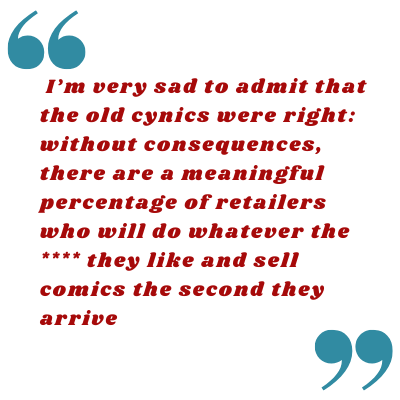
This has severe downstream impacts as well, because if you’re not feeding in new readers via serialization, generally speaking the eventual book collection a) becomes more expensive itself (further limiting the audience) and b) has less word-of-mouth consumer interest pushing and promoting it. We nearly always, even as a book-focused store, sell serialized work to more consumers in the first year or two than we do of the collected editions. For our personal store top-seller of “Saga”, it is a bit more than two-to-one, while on Marvel and DC superhero comics, the ratio is closer to ten-to-one on average. The clear inference from this is that generally the more periodicals you were able to sell, the more books you can sell – the periodical feeds the book.
What about the problem of the radical lowering of wholesale discounts to retailers caused by the split in the market requiring orders to be placed at at-least three different distributors for periodicals? Not only does this increase labor (for no real benefit to the retailer), but it directly loses us points – basically every moderate-sized comic book store lost at least five base percentage points from their number one publisher, Marvel, so that even if that was offset slightly by “free shipping”, it still means significantly higher costs to most.
And it has essentially broken Diamond’s math on their remaining vendors: In 2021 I paid $9,824.67 in shipping to Diamond on $184,521.87 of wholesale purchases. That’s about 5.32% of the wholesale invoice that went to shipping. In 2022 I paid $10,152.60 in shipping to Diamond on $89,666.48 of wholesale purchases. That’s about 11.32% of the wholesale invoice that went to shipping.
This is a real problem, because if we can’t make a rational profit selling periodicals, there is nothing to do but cut orders.
Connected to all of this the now seemingly Wild West “moving target” of release dates. When Diamond was the sole periodical source many many retailers pushed long and hard (and I mean we worked for decades to make this happen) to have industry-wide consistent on-sale dates that were very specifically a special day for comics to be on sale: Wednesday. This was all thrown in the trash when Diamond pulled out of the DM ecosystem, and all enforcement of on-sale dates were chucked out as well. I’m very sad to admit that the old cynics were right: without consequences, there are a meaningful percentage of retailers who will do whatever the fuck they like and sell comics the second they arrive if they can get a one day (or one minute) advantage over others.
Prior to the 2022 holidays, we’d come to a consensus that we’d “take a week off” between Christmas and New Years. First, because so many of our regular customers are traveling, but also because that holiday week shipping is typically a logistical disaster with winter storms, and vast amounts of home-delivered goods clogging up the shipping stream from UPS, etc. This year, we received what I think was the largest single week of shipped periodical comics we had of all 2022, and it shipped as much as ten days before its “on sale” date (as well as about five days after!), but what we found was that a really large percentage of stores just put it on sale as soon as it arrived, destroying the promise of an equal market. And, for us, at least, the sales we had in that post-Christmas frame were nowhere near what the flood of product that arrived in that period.
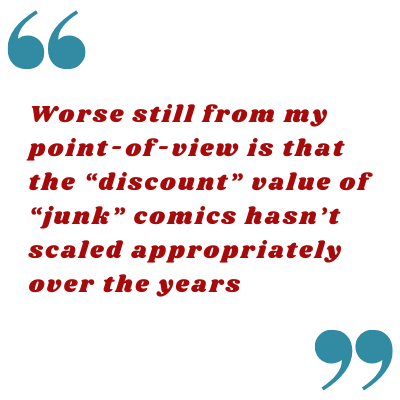
Finally, although this is always perpetual problem in comics: There is very little to-consumer promotion and marketing. The funny thing is that you would think that the growth of social media would make it that much easier for entities with actual marketing and PR budgets and staff, but it has never changed that the first time that the overwhelming majority of customers have the slightest amount of knowledge about most new comics is when they walk into a store and see it.
When you take this all together: Radical overproduction of series, dependence of FOMO variant publishing programs, emphasis of mini-series and restarts rather than long-term commitments, price increases, squeezing retailer margins and no longer protecting an equal marketplace for the class, as well as not marketing the work to the end-reader, it’s not actually surprising that periodical comics are suffering.
What surprises me, though, is that this is the eco-system that the “mainstream/DM” publishers operate within, and there doesn’t appear to be a meaningful way for them make money outside of that eco-system that doesn’t depend on reducing your creation costs to near-zero – like US Manga and Webcomics publishing seems to be dependent upon…. and so why are you killing your golden goose?
There is a special and precious thing that we have from the specific “mom-and-pop” nature of the independent periodical-driven Direct Market. I think it allows for a broadly democratic access to the market that isn’t solely based on the ability of an artist to promote themselves. I don’t want to lose this thing.
* * * * *
Want to help preserve it? About a month from today is ComicsPRO’s membership meeting – the first in person in several years, and this time on the East Coast, in Pittsburgh. If you are a retailer or publisher or creator, you should make a plan to attend. It’s always the most useful 72 hours I spend any given year.
**************************
Brian Hibbs has owned and operated Comix Experience in San Francisco since 1989, was a founding member of the Board of Directors of ComicsPRO, has sat on the Board of the Comic Book Legal Defense Fund, and has been an Eisner Award judge. Feel free to e-mail him with any comments. You can purchase two collections of the first Tilting at Windmills (originally serialized in Comics Retailer magazine) published by IDW Publishing, as well as find an archive of pre-CBR installments right here. Brian is also available to consult for your publishing or retailing program.
Sponsored by Battle Quest Comics



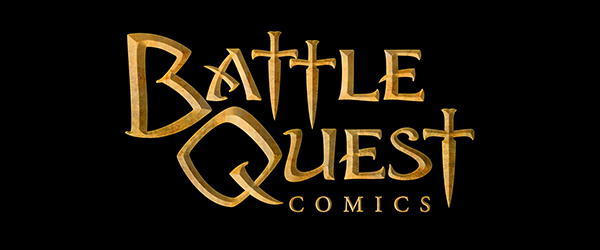
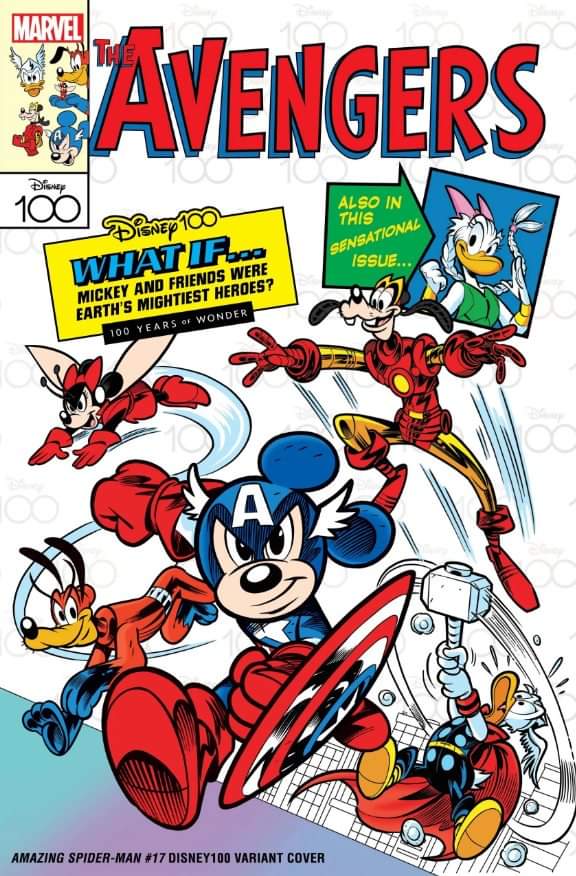
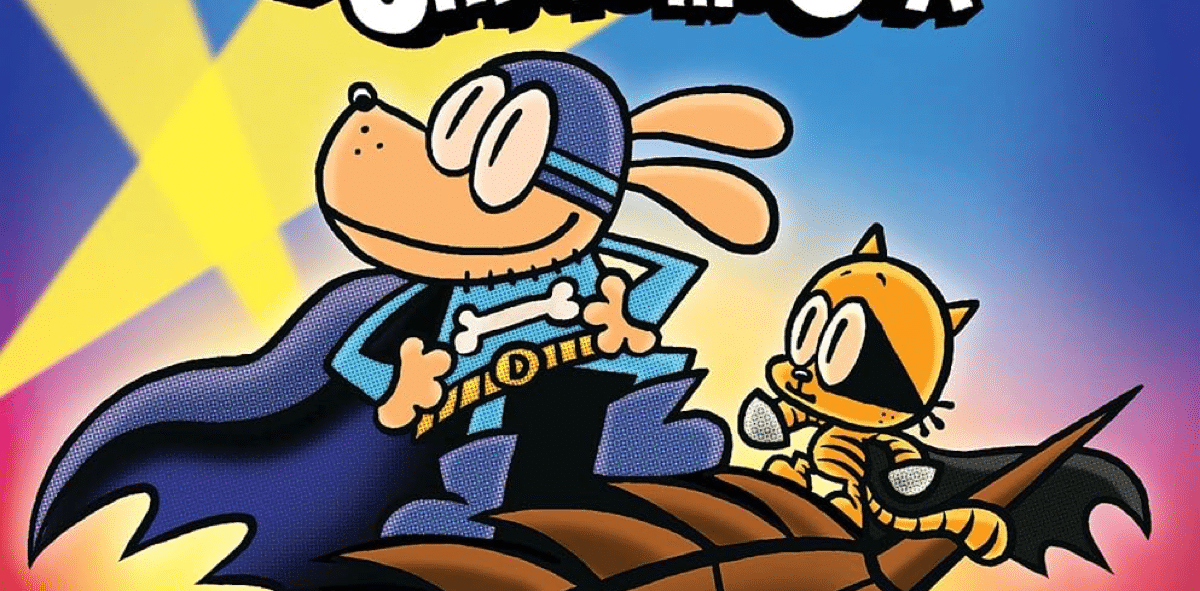

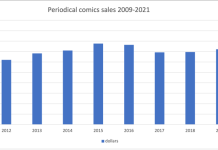


Ugh, typos! In the para about “the Wild West”, I of course meant to type “when DC pulled out of the DM ecosystem….”
I agree that the variant covers is the issue that is severely killing this industry. Dynamite Entertainment being the biggest offender. I no longer argue with my LCS in trying just to secure the A cover: I just get whatever comes in, the b&w version, the virgin cover, the photo cover, etc, – it’s all freakin’ out of control. None of these gimmicks increase or decrease the value of the cover. Barely any of Dynamite’s licensed book make a dent year after year in The Overstreet Guide anyway.
Now I hear that DC Comics is overtaking the coveted variant cover crown. Their variant covers can span now span the entire alphabet and THEN some of any given $9.99, 1st issue or anniversary event. I never realized until now, that it’s nothing but a big giant pissing contest between publishers.
Word of advice: KNOCK IT OFF ALREADY!!
~
Coat
YES! Thank you for articulating the problems with variant covers so perfectly- “The real problem with the SKU-bloat of Variant covers is that it is largely a publishing methodology based on fear, rather than one of joy and wonder and fun.”
I really think it’s time you find a new career. This clearly isn’t working out for you and your echo chamber of old whiners.
While I agree with you on the problem of too many variants. But your store must be in the Twilight Zone. And I hate to say this , but that “Old Whiners” comment above is so on the money (and their stores are probably located in the same “Twilight Zone” of your store. My store has 8 or so stores , within a 10 minute drive of our location. And I know each of the other store owners , 7 of the 8 stores , will tell you , what I am about to state. New Comic sales have not been this good , in 20+ years. The one store owner who is always complaining about “bad sales” , is a pure Comics-Gate guy , everything is woke , blah , blah , blah. From your posts you seem to lack excitement for the product. Every week , we make a few titles an “Event” , with a real enthusiasm for the product. Minus the COVID era , we always have a line when we open the doors on Wens.
I agree that there are way too many variants and some bizarre theme choices. Who is really looking for a Planet of the Apes/Marvel variant cover, much less a dozen? I actually like the Disney 100 variants and was excited to get one for my 5-year old (of course she can’t read the underlying comic). But also agree that it’s weird that the variant is for ASM and not for Avengers. It probably would have made more sense on the one all-ages title that Marvel is publishing: Double Trouble.
Another variant sin is doing an ongoing series (like Russell Dauterman’s costume variants) but randomly making some incentive and some not.
I’m going to continue with my points because I don’t think you can see the forest for the trees anymore Brian. I asked last time and I’ll ask every time and I know you won’t respond because you’ll just say you don’t have to with a nameless person online, and that’s fine, but have you ever thought that maybe all of this whining and crying you do about the death of comics may keep people from wanting to shop at your store? Do you think maybe as costs have risen and prices have increased and shipping has risen that you should have looked at your expenses and cut back in certain places? How many full time employees do you need for your store? Most local comic shops, mine included, have one. The owner. Maybe a couple part timers that help me around the shop or put in a few hours here and there. But how many full time employees do you have and need? What are your hours of operation? People work for their lives and a lot of people don’t get off until 5 pm or after. Have you thought about maybe staying open later to catch people after work? Or do you just expect those people to make time for you?
Prices have risen on everything, not just comics. Have you been to a grocery store recently? Prices are high. Things cost more. Shipping anything costs more. So you’ll have to pay more and you’ll have to figure it out as you go because that’s what owning a business means. If everything stayed static in price, would you have enough money from selling so many thousands of comics at 10 cents a piece to pay your staff? I doubt that highly.
And comics have been dying since the Image guys left Marvel and since there were a million variants on every book in the 90s and since foil and chromium covers were a big thing and since Fredric Wertham blamed comics for the seduction of the innocent. This is nothing new. Comics have had variant covers in some way, shape, or form for at least the last thirty years. They don’t always make sense. They aren’t always that good. But you as the business owner can decide what you order and sell and you can let your customers decide what they’re going to buy. That’s how the whole game works.
But again, I doubt you’ll listen and you’ll keep loudly whining and crying about the business and cutting off your nose to spite your face because this is how it should be in your mind and nothing will ever get through to you. Just don’t be surprised by the large numbers of people who you are turning away from wanting to ever shop at your store when they look it up and see articles like this on the internet.
Well that was depressing. But accurate and well informed. On an off collector for going on 50 years now, stopped in the 90’s due to just crap being pumped out. The variant’s are a silly marketing idea, short term gain maybe. The recent Jack White cover of Worlds Finest is a perfect example, a cover that looks like I could have drawn it instantly selling for 10x cover.
Spot on as usual Brian, multiple points I’ve been bringing up at our manager meetings as well – trying to encourage the managers not to order out of fear of missing out, is a big one, and something I’m guilty of as well. Typical that the supposed retailers complaining about your posts don’t have the courage to name themselves, their stores, or point out that they’ve only been in business since 2020 and this is their best year ever! Graham Crackers Comics is going on 41 years in business, we’ve got 13 locations and we’re dealing with everything you mentioned above. Our mix of trades vs monthly sales are nowhere near your ratio – but I get that you’re not saying that everyones sales ratios are the same. I’m afraid the points that they’re missing, that these continued business practices harm everyone – even their stores that are selling more new comics than ever before – you want long term improvements, not short term cash grabs to sustain your business.
Our website manager pointed out that 5 or 6 years ago we had at least 7 customers in the chain that bought ‘ALL AMAZING SPIDER-MANs’ – we currently have ZERO. Marvel & DC have single handedly destroyed those buying habits “I get them all” – by making it a nearly impossible task unless you’re independently wealthy.
Thanks as always for your impressive record keeping, and taking the time and courage to post hard numbers.
Wow. A lot of personal attacks in the comments. I don’t see how that is at all helpful.
Brian,
I only really buy collections anymore, but I have noticed a lot of what you touch upon. There is no longer a consistent on-sale date. I’ve been shocked to see new comics on sale on Mondays and Tuesdays. Also – the plethora of mini-series is very confusing.
It’s hard to be a customer now and I can’t imagine how difficult it is to run a business right now with these comic companies working against the health of the industry.
I agree on the continuity side, which means I buy very few ongoing Marvel or DC series – Daredevil being the only real main universe exception I can think of at the moment, and I’ll drop that if/when they bring in Avengers, or X-Men. The various Sandman Universe runs also work for me, but again you don’t need to know what’s going on in 40 other books to follow them
One Bad Day I have less of an issue with, as they are stand-alone, but agree there are other cross-overs that imply they are stand alone that aren’t, so I’ll only pick up a Lonely City, or Rogues on the DC side
@”Booster Silver”, yes you are correct that I tend to entirely disregard anonymous trolls on the internet, because if you don’t have the bravery to stand behind your opinion with your real name, how much value can it possibly have? But, having said that, this one time I will indulge you.
Q: have you ever thought that maybe all of this whining and crying you do about the death of comics may keep people from wanting to shop at your store?
A: I object to any characterization of statements of “the death of comics”, because that’s a profoundly vapid and shallow analysis of what I am discussing, but sure, “should I let people know how sausage is made?” is perpetually thing I consider. But that doesn’t comport with a) the things our customers are incessantly saying to us about how much they love our store and the shopping experience we provide, or b) the things I observe and discuss with my fellow local retailers about THEIR experiences (or even the majority of retailers outside of my area). There is a truly meaningless percentage of local customers reading retail-analysis on websites, and has been for the multiple decades I have written this column.
I also feel compelled to note that MULTIPLE major publishers, as well as large retailers (cf: Graham Crackers above) have written to me privately about this particular column and said that they agree with everything I say here, so….?
Q: Do you think maybe as costs have risen and prices have increased and shipping has risen that you should have looked at your expenses and cut back in certain places?
A: Like any smart and successful business person I, of course, am incessantly analyzing costs and benefits. This is one of the primary reasons that we’ve radically pulled back from going deep on periodicals over the last decade in favor of the book format.
Q: How many full time employees do you need for your store? Most local comic shops, mine included, have one. The owner. Maybe a couple part timers that help me around the shop or put in a few hours here and there. But how many full time employees do you have and need?
A: The number that we DO have, is the answer — and actually, we run much shorter than I would prefer, because there’s ALWAYS work that is behind, but there are always limitations between what one wants ideally, and what is rational to afford. I personally believe that any business that is “just the owner” isn’t really much of a business, but is more of a “hobby”, but if that works for “most” of your local competitors, who am I to judge?
Q: What are your hours of operation? People work for their lives and a lot of people don’t get off until 5 pm or after. Have you thought about maybe staying open later to catch people after work?
A: Locally, I think we run the “correct” hours (or close to it, at least). We run virtually the same hours as ALL OTHER retail businesses in our neighborhood, and virtually every attempt to expand those hours has yielded no more than break even because we find we tend to make the same amount of money, just spread out over more hours and with greater costs in staff and utilities. We REGULARLY try experiments with different hours; I’m not a fool.
I hope this satisfies your illogical assumptions that I am willfully running my business incorrectly for my market. And if not? Really don’t care.
How long have you owned your store, Booster Silver? What’s your website?
The constant restarts are so frustrating! I have a nine-year-old son who, by some miracle, actually reads comic books. I mostly get him trades because he reads so fast & the monthlies are just too pricey. It has been hard trying to figure out which volume of Spider-Man or Batman follows what & how that relates to their spin-offs… Ugh.
It’s true that consistency is what fans want. I thought The Walking Dead was one of the most poorly written comics of modern times but the consistency in numbering, creative team, etc.- the readers could commit to this. Same with ‘Saga’. Marvel and DC have no new ideas that they haven’t strip-mined from the past and their lack of planning has sunk their future. Seriously, the constant re-numbering and so forth- none of this is accessible. It’s a self inflicted wound and I finally get why I see so many kids reading Manga instead of trying to make sense of the Big 2. Y’all did it to yourselves. Wizard Magazine helped….
Its always tough to make it thru these pieces and their need to wallow in the past—nobody gives a hoot about the market in 1989 but you, my dude—but what you have done here is describe a product that needs to die. As you yourself describe it, Publishers dont want to make or support them, retailers lose money on them, and customers barely care about them. Let it go…
Mr. eggbert, allow me to respond
“Publishers dont want to make or support them”
Farthest thing from what anyone is stating. Publishers make the majority of their money from the periodical. The Comic Book industry is the only periodical publishing end, where the numbers are stronger then they were in 2002.
“retailers lose money on them”
I don’t think any retailer is stating this, are some stores making more money then other retailers? Sure, but that happens in any business. I am supporting my family, and paying two fulltime employees, well enough, to gainfully support their families.
“customers barely care about them”
We have more pull and hold customers in 2023, then at anytime in our history. We have more competing stores then anytime in our communities history. Brian makes some very good points in his column. And I understand what works for me, may not work for him in San Francisco. I am sure his rent (or mortgage) is triple what mine is.
Bottom line is this, the industry is stronger, if we are able to find something that works for stores in Maine to stores in Hawaii.
Interesting.
@bwg
“Publishers make the majority of their money from the periodical.” You sure about that?? You’d be surprised.
“the numbers are stronger then they were in 2002.” Are you selling more units or less units than 2002? And here comes the $4.99 periodical!
“We have more pull and hold customers in 2023 then (sic) any anytime in our history.” Since you are posting anonymously this claim means absolutely nothing.
“…if we are able to find something that works for stores in Maine to stores in Hawaii” what are you even talking about here? Didn’t you just point out the rent differentials between stores in different regions?
@eggbert
“Publishers make the majority of their money from the periodical.” You sure about that?? You’d be surprised.
This is DC , so other Companies , may look different Periodicals 60%. TPB 35% Misc 5%
“the numbers are stronger then they were in 2002.” Are you selling more units or less units than 2002? And here comes the $4.99 periodical!
You have to remember 2002 , was not huge year
The Big books : Bats, ‘Tec , Action , Superman have all doubled (and the Superman bounce is the last couple of years. but the hold numbers in 2002 Bats was the only book doing close to 200I now the hold is over 400+ ….should mention Nightwing , holds are 10X then they were in 2002 , cracking 250, and every month adds new people …Great job , Tom , Thank you
Also in 2002 , you did not have Tom King , also the oversized format , als0 The Mini’s and the Maxi , 10X stronger in 2002, DC doesn’t miss on these type of titles
Marvel numbers from 2002 are the same in 2022 , maybe a little weaker.
Marvel does not hold their fanbase as they become older
DC on the other hand lose’s maybe a handful of people at best, each year
DC readers/collectors are loyalists , we have a bunch of serious buyers ,that buy every DC title
Marvel doesn’t have one
DC also seem to have more of a higher income type of person ( many Doctors, Lawyers , Judges , etc )
Many of our DC fans have every DC book, published from 1960/70 to now
Definitely 2 different buyers
Also nearly zero crossover , DC fans buy DC , Marvel Fans buy Marvel
Indie buyers buy Indie ,but I will admit , this is my most worrisome category
because if there isn’t a huge title like Walking Dead
month in and month out
“…if we are able to find something that works for stores in Maine to stores in Hawaii” what are you even talking about here? Didn’t you just point out the rent differentials between stores in different regions?
I am talking about Sales techniques , make every new comic book day, an event ,there are always 3 or 4 titles each week, that are quality , and that you can hand sell (now in out store it is usually DC titles , but I am sure Marvel stores or Indie stores can do the same
Comments are closed.